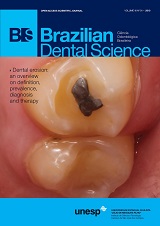Sintering dental porcelain with CO2 laser: porosity and mechanical characterization
DOI:
https://doi.org/10.14295/bds.2013.v16i1.856Abstract
Aim: This work evaluated dental porcelain sintering by CO2 laser irradiation. Methods: Two commercial veneering porcelains were used: VM7 and VM9 (VITA Zahnfabrik). Porcelain disks (0.35 mm dia. x 2.0 mm) were sintered by a continuous CO2 laser (Coherent, USA – 35 W e ?= 10.6 ?m) in two irradiances (20 and 23 W/cm2) and exposure times: 5 and 10 min. A control group was sintered in a conventional oven following manufacturer’s instructions. After sintering, one of the disks surfaces was mirror polished. Superficial pores (%) were assessed by images obtained in an optical microscope (100x) submitted to the software Image J analysis. Apparent density was measured by Archimedean’s method. Microhardness and fracture toughness (Indentation Fracture - IF) were determined with a Vickers indenter (Shimadzu). Results: Porosity ranged between 4.0 and 5.9% for irradiated specimens; control group had 6.0 and 4.7% of porosity for porcelain VM7 and VM9 respectively. Density of porcelain VM7 irradiated for 10 min. with irradiance of 23 W/cm2 was significantly higher than control group. Microhardness and fracture toughness of irradiated specimens were similar to control. The measurements of some irradiated groups were not possible to achieve because the tests revealed irregular marks after indentation. Conclusions: Porcelain sintering with CO2 laser in some fluences produced a material with superficial porosity similar to that obtained in conventional oven. Microhardness and fracture toughness could not be measured for all irradiated groups suggesting some subsuperficial defect caused by entrapped gases or cracks originated by temperature gradient along the specimen.
Downloads
Downloads
Published
How to Cite
Issue
Section
License
Brazilian Dental Science uses the Creative Commons (CC-BY 4.0) license, thus preserving the integrity of articles in an open access environment. The journal allows the author to retain publishing rights without restrictions.
=================




























